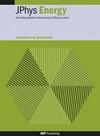Emergent evolution of first-order phase transitions from magneto-structural to magneto-elastic in MnCo1−y Fe y Ge1−x Si x alloys
IF 6.3
3区 材料科学
Q1 ENERGY & FUELS
引用次数: 0
Abstract
The emergent evolution of first-order phase transitions from magneto-structural to magneto-elastic and magnetocaloric effect (MCE) have been investigated by X-ray diffraction, differential scanning calorimetry and magnetization measurements. Applying the isostructural alloying principle, the martensitic transition temperature (T M) increases effectively and the Curie temperatures of the two phases increase slightly by substituting the Si content (x). With an appropriate amount of Fe and Si content, an emergent first-order antiferromagnetic–ferromagnetic magnetoelastic transition with thermal hysteresis in the martensitic state occurs for MnCo0.7Fe0.3Ge1–x Si x (x = 0.15–0.40) alloys, which results from the decrease in the nearest-neighbor Mn–Mn distance. Moreover, the values of magnetic entropy change (ΔS M), refrigeration capacity (RC) and temperature-averaged entropy change (TEC, 10 K) with ΔH = 50 kOe reach −12.2 J kg−1 K−1, 112.8 J kg−1 and 11.4 J kg−1 K−1 for MnCo0.7Fe0.3Ge0.8Si0.2 undergoing the ferromagnetic magneto-structural transition in the Curie temperature window. The results facilitate the magnetocaloric/magnetoelastic performance and tunability of multiple phase states in a wider temperature range.MnCo1−y Fe y Ge1−x Si x合金中从磁结构到磁弹性一级相变的涌现演化
用X射线衍射、差示扫描量热法和磁化测量研究了从磁结构到磁弹性的一阶相变的涌现演化和磁热效应。应用同构合金化原理,通过取代Si含量(x),马氏体相变温度(TM)有效提高,两相居里温度略有提高。在适当的Fe和Si含量下,MnCo0.7Fe0.3Ge1–x Six(x=0.15–0.40)合金在马氏体状态下出现了一阶反铁磁-铁磁磁磁弹性跃迁,其热滞后是由于最近邻Mn–Mn距离的减小所致。此外,当ΔH=50kOe时,MnCo0.7Fe0.3Ge0.8Si0.2在居里温度窗口经历铁磁结构转变时,磁熵变(ΔSM)、制冷量(RC)和温度平均熵变(TEC,10K)分别达到−12.2 J kg−1 K−1、112.8 J kg−2和11.4 J kg−1K−1。这些结果有助于在更宽的温度范围内提高多相态的磁热/磁弹性性能和可调谐性。
本文章由计算机程序翻译,如有差异,请以英文原文为准。
求助全文
约1分钟内获得全文
求助全文
来源期刊

Journal of Physics-Energy
Multiple-
CiteScore
10.90
自引率
1.40%
发文量
58
期刊介绍:
The Journal of Physics-Energy is an interdisciplinary and fully open-access publication dedicated to setting the agenda for the identification and dissemination of the most exciting and significant advancements in all realms of energy-related research. Committed to the principles of open science, JPhys Energy is designed to maximize the exchange of knowledge between both established and emerging communities, thereby fostering a collaborative and inclusive environment for the advancement of energy research.
 求助内容:
求助内容: 应助结果提醒方式:
应助结果提醒方式:


